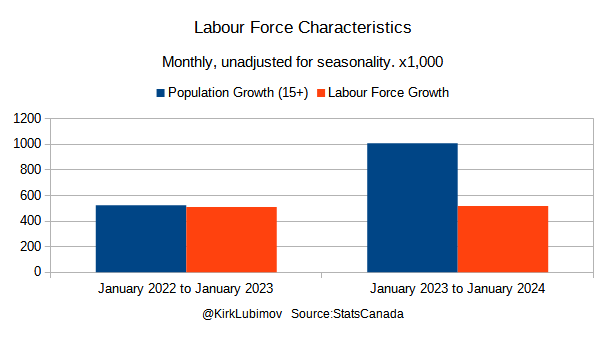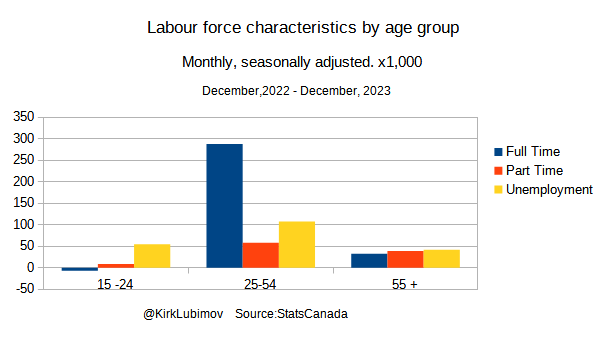In 2023 Canada has immigrated over one million people, the federal government handed out billions of dollars in subsidies trying to attract industry, and small businesses have had a tough year. Canada is a hiccup away from being considered in a technical recession and would have been in one if not for the spending on public sector growth.
There are a lot of moving parts in the economy right now coupled with record unaffordability, and the labour force is one of the places to see how and which parts of the economy are working but also to see trends and stability.
In Canada, the employable population is age 15 plus, which has grown substantially in 2023. From January 2023 to January 2024 that population grew by just over one million people which is a sizable increase from January 2022 to January 2023 which was just over five hundred thousand people.
The labour force grew by just over 516k people with employment going up by 341k made up of 212k full-time jobs and 129k part-time jobs. Unemployment increased by 175k. The rest have not entered the labour force and that number is 491k people.
In other words, each new full-time job had to support over 5 new people. It is not only an alarming ratio but also a significant falloff from the previous year.
Over the same period of January 2023 to January 2024, one-third of the full-time jobs created were in Alberta, followed by British Columbia, and Ontario. Western Canada created around 73% of the full-time jobs and Quebec lost 1k full-time jobs.
Quebec has a large portion of Canada’s asylum seekers thanks, partially, to the open border that was Roxham Road and the financial assistance they are paying out growing fast. From 2022 to 2023 the amount of dollars in last-resort financial assistance to asylum seekers that was paid out grew by 127%. Not being able to create jobs is especially devastating for the province.
2023 was especially a tough year for youth and the elderly. From December 2022 to December 2023 the 15 to 24-year-old age group didn’t gain any full-time jobs. They actually lost just over 7k jobs and got just over 8k part-time jobs while unemployment grew by over 54k people.
For the over-55-year-old crowd, right before retirement, the main growth was in unemployment and part-time jobs, while full-time jobs lagged behind them both.
Both demographic categories are at a crucial point in their working lives; entering and setting to exit their careers. This economic let-down means they will need more support.
The magnification of employment in Canada comes at the hands of bloating the public sector. From January 2023 to December 2023 the private sector has gained 414.k job but going into January 2024 it lost 207.2 jobs, giving it a year-over-year growth of just 206.2k jobs.
The public sector in comparison grew by 177k over the same period. Canada just isn’t producing enough private sector tax base to pay for the public sector growth. The number of self-employed decreased by 41.7k as the country continued to bleed risk-taking and entrepreneurship.
Education-wise, the employment rate dropped for those with advanced degrees, bachelor’s degrees, and some postsecondary and university degrees in general. The employment rate increased for these with some high school, high school graduates, and postsecondary certificate and diploma holders. It gives a glimpse into the quality of jobs that have been created.
The average hourly wage rate grew from $33.01 to $34.45 an hour (monthly, unadjusted for seasonality). The agriculture industry saw the smallest hourly wage growth over 2023 going from $23.17 to $23.36 an hour. The utilities industry has finished the year with the highest average hourly wage of $51.42.
Canada saw a labour force drop in several occupations in 2023 from 2022. The ones I am worried about the most are machine operators, general trades, supply chain logistics, natural resources, agriculture and related production, natural and applied sciences, health treating and consultation services professionals, assisting occupations in support of health services, and professional occupations in education services.
These are all technically skilled, crucial jobs for nation-building and productivity increasing. We need to attract businesses that can provide these kinds of jobs. We also not replacing adequately enough retiring technical talent.
The industries that have lost employment in 2023 vs 2022 are agriculture, retail trade, real estate rental and leasing, business, building and other support services.
The discrepancy between which industries Canada lost employment in and occupation growth doesn’t speak to as much that we have a labour shortage but more that Canada needs to keep attracting and creating manufacturing and growth-orientated industries to capture skilled talent.
We are losing businesses due to our economy and also starting to see the impacts of innovation in the disposition of skilled labour force. It is paramount to keep creating a pipeline of startups and companies to capture that labour force and attract more of it or they will leave. Attracting it back will be more expensive, require much more effort, and reduce our competitive advantage.
Creating a fruitful, enabling environment for talent to start high-potential, and innovative companies should be one of Canada’s biggest focuses as a strategy for our labour force.





